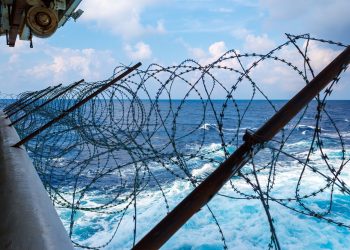he vast majority of cargo containers entering the U.S. go unchecked
 It’s been more than a decade since Islamic terrorists attacked the U.S., yet the agency created to protect the nation from another strike is asleep at the wheel, failing to adequately screen the monstrous amounts of cargo that enter the country each day, according to a government report issued this week.
It’s been more than a decade since Islamic terrorists attacked the U.S., yet the agency created to protect the nation from another strike is asleep at the wheel, failing to adequately screen the monstrous amounts of cargo that enter the country each day, according to a government report issued this week.
“Cargo containers that are part of the global supply chain– the flow of goods from manufacturers to retailers — are vulnerable to threats from terrorists [including weapons of mass destruction],” state thegovernment analysts whoassembled data forthe new report.
Itmay seem unbelievable to most Americans that the Department of Homeland Security (DHS) that more than ten years after the worst terrorist attack in U.S. history, the vast majority of cargo containers entering the U.S. go unchecked. Incredibly, it’s true and the alarming details are outlined in the GAO report published this week by the Government Accountability Office (GAO), the investigative arm of the U.S. Congress.
The Maritime Transportation Security Act (MTSA) of 2002 and the Security and Accountability For Every (SAFE) Port Act of 2006 required the Department of Homeland Security (DHS) to take actions to improve maritime transportation security.
Also, the Implementing Recommendations of the 9/11 Commission Act of 2007 (9/11 Act) required, among other things, that by July 2012, 100 percent of all U.S.-bound cargo containers be scanned. Within DHS, U.S. Customs and Border Protection (CBP) is responsible for container security programs to address these requirements.
Sadly, the GAOreportreveals that the DHS agency responsible for screening cargo, Customs and Border Protection (CBP), still lacks the ability to check 100% of the containers that enter the U.S. through seaports each day. Under the 9/11 Commission Act, all U.S-bound cargo containers must be scanned because they are vulnerable to threats from terrorists and could be used to smuggle nuclear and radiological materials.
To meet the goal, DHS has spent hundreds of millions of dollars on faulty systems that didn’t get the job done. In fact, the agency dropped more than $200 million on 1,400 radiation portal monitors that weren’t up to the task, according to ablog published bya public-interest group that investigates and exposes government corruption and ineptitude — Judicial Watch.
“Uncertainty persists over how DHS and CBP will fulfill the mandate for 100 percent scanning given that the feasibility remains unproven in light of the challenges CBP has faced implementing a pilot program for 100 percent scanning,” state the GAO investigators.
In addition, the GAO reveals that several years ago it asked Homeland Security officials to perform an analysis to determine whether 100% scanning is even feasible, but the agency hasn’t bothered doing it.
Congressional investigators have logically concluded that CBP is “no longer pursuing efforts to implement 100 percent scanning” by the mandatory July 2012 deadline.
The GAO reveals that several years ago it asked Homeland Security officials to perform an analysis to determine whether 100% scanning is even feasible, but the agencynever didit. Congressional investigators have logically concluded that CBP is “no longer pursuing efforts to implement 100 percent scanning” by the mandatory July 2012 deadline.
The GAO’s findings could not have come at a worst time, on the heels of an international study on maritime trafficking that reveals weapons, drugs and banned missile are regularly smuggled aboard reputable ships owned by major companies in the U.S. and Europe.
As an example it lists the case of weapons traffickers who evaded international embargoes on Iran and North Korea by hiding illegal goods in sealed shipping containers using a tactic pioneered by drug smugglers.
The GAO report concludes: “Uncertainty persists over how DHS and CBP will fulfill the mandate for 100 percent scanning given that the feasibility remains unproven in light of the challenges CBP has faced implementing a pilot program for 100 percent scanning. In response to the SAFE Port Act requirement to implement a pilot program to determine the feasibility of 100 percent scanning, CBP, the Department of State, and the Department of Energy announced the formation of the Secure Freight Initiative (SFI) pilot program in December 2006.”
Source: Jim Kouri, Examiner
































































